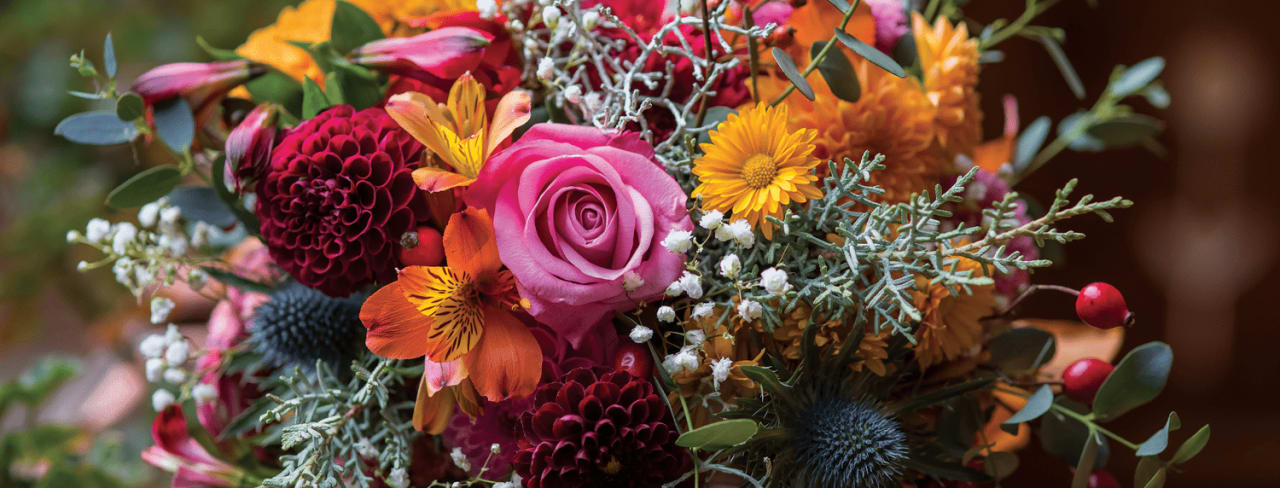In Bloom | The Art of Floral Arranging
Your Home & Lifestyle Magazine
Nothing says spring quite like a fresh bouquet of flowers. Shake off the winter doldrums—and keep your wallet recouping from the holidays—with a DIY arrangement of your favorite blooms.
Plan Ahead.
A little planning goes a long way in creating a beautiful, lasting arrangement. Whether you’re sourcing from a farmer, florist, or grocer, opt for flora that’s locally in season whenever possible. You’re likely to get the best deal and product.
Build Your Base.
Before grabbing those shears, check the height of your vase. A good rule of thumb for the overall height of an arrangement is around one-and-a-half times that of your vase. Anything less and you risk the design looking unbalanced or unfinished.
While it’s not a requirement, adding structural aids—known as “mechanics”— can help maintain the shape of your arrangement. Floral foam is easy to find, but chicken wire and crisscrossed tape are eco-friendly options that may already be in your home. (If you have a floral frog, even better.) Feeling fancy? Order some green, waterproof tape or floral tack to arrange like a pro.
Prep Your Flowers.
When priming flowers and greenery for your arrangement, make sure to freshly trim stems with clean, sharp shears. This increases water absorption and minimizes damage, reducing opportunities for bacterial growth. Many florists recommend cutting the stems at a 45-degree angle, about one inch from the bottom. You should also remove any excess leaves that will fall below the waterline.
Arrange Away.
Like any work of art, there’s beauty to be found in imperfection. Get creative and have fun playing with color, depth, and texture. Experimentation is half the fun but may seem daunting if you’re new to arranging. Turn to a color wheel for fail-safe inspiration. Start with analogous colors or hues for a softer look or go bold with complementary colors. Still unsure? Pull colors from your favorite showstopper, building your arrangement around the flower’s natural palette. Don’t forget that greenery varies in color, too!
When determining placement, it’s helpful to consider the four categories often used by florists: line, focal, filler, and greenery. Line flowers like delphinium and larkspur, with clusters along tall stems, add dimension. Focal, or form, flowers are your eye-catchers—the bold blooms you build an arrangement around (think peonies, dahlias, and garden roses). Filler flowers like carnations and sweet pea are smaller but, coupled with your chosen greenery, play a big role in the overall aesthetic.
For a more traditional arrangement, create three tiers of floral heights, with a collar of greenery and filler to form the foundation of your arrangement. Want something more whimsical? Mimic nature with a greater number of filler flowers and more delicate blooms. Add sprigs of greenery in multiple directions to keep the shape less uniform. No matter your vision, work with the natural shape of individual flowers and stems to create softer, pleasing lines.
Extend Your Blooms.
Enjoy the fruits of your labor longer by frequently replacing the water in your vase and using plant food. Make food from a variety of household staples; a combination of something acidic and something with sugar will keep stems nourished and healthy. And while growing flowers appreciate ample sunlight, placing cut blooms by a window is a floral faux pas. Keep your arrangement away from direct sunlight and extreme temperatures for added longevity.
-
how does your garden grow?
Growing your own cut-flower garden is a sustainable and traditional way to keep your home in bloom all season long.
Plant your seeds in narrow sections with plenty of pathways. This ensures all your blooms are accessible when it’s time to harvest. Raised beds are another excellent option, particularly if your garden’s natural soil is lacking.
Focus on long-stemmed annuals, perennials, and bulbs. Include high-yield, “cut-and-come-again” varieties like cosmos, asters, and snapdragons to maximize your garden space.
Use succession planting for a longer growing season. Replant hardy annuals that can be sown directly into the soil, like sunflowers and zinnias, for replenished blooms into the fall.
Don’t forget the filler flowers and greenery. Plant more than you think you’ll need for bouquets that look lush and full.
-
YHL/ Written by Victoria Hittner
Photography by zozzzzo/iStock/Getty Images Plus
